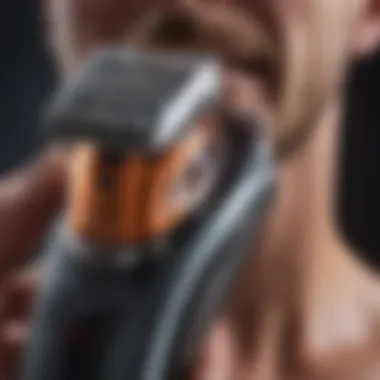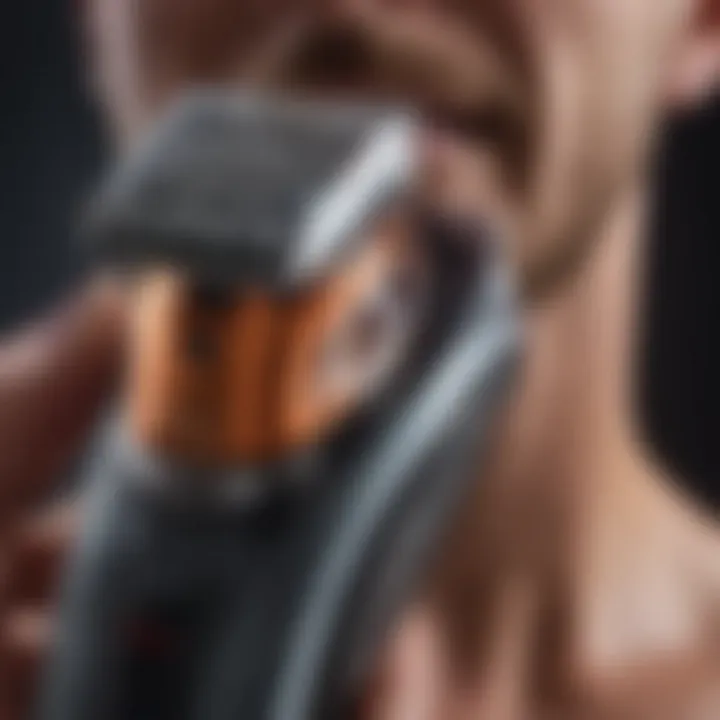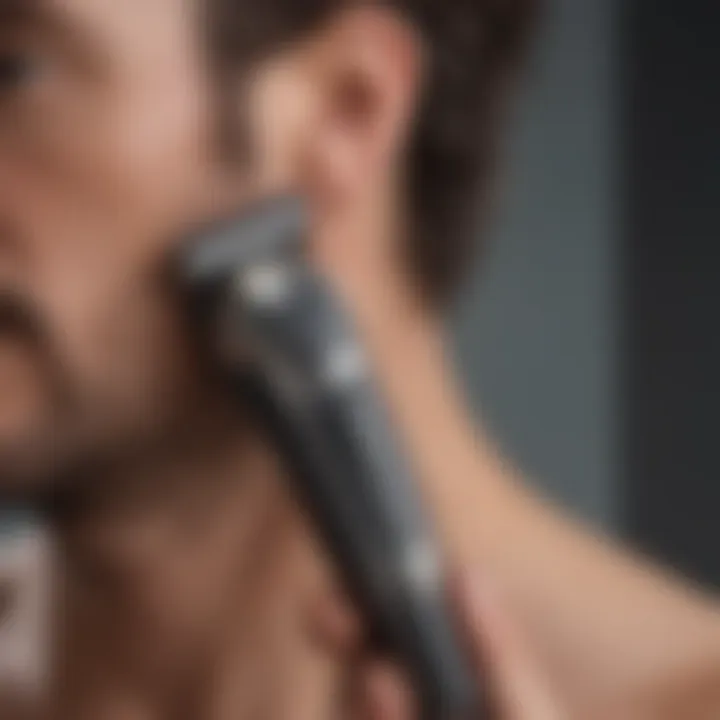Best Trimmers for Groin Area: Comprehensive Guide


Intro
Selecting the right trimmer for the groin area is crucial for anyone seeking an effective personal grooming routine. The skin in this region is sensitive, which makes it imperative to choose a device that combines precision with comfort. This guide aims to highlight various aspects regarding the use of trimmers designed specifically for this sensitive zone.
Understanding the features essential for safety and efficiency can make a notable difference in the grooming experience. When choosing a trimmer, factors such as blade type, battery life, and ergonomic design play significant roles. Furthermore, knowing the unique requirements of different skin types and hair textures is necessary for achieving optimal results.
In this comprehensive guide, we will discuss key trends in grooming devices, outline safety considerations, and provide a list of recommended models tailored to various needs. Hints on maintaining these devices to prolong their lifespan will also be part of the conversation, ensuring that readers are well-equipped to manage their grooming routines effectively.
The following sections will delve into the nuances of selecting the best trimmers for the groin area, focusing on details that truly matter.
Understanding the Need for Specialized Trimmers
Grooming the groin area often requires specialized tools that cater to unique needs. This section focuses on why trimmers specifically designed for this sensitive region are essential and impactful.
Defining Groin Area Grooming
Groin area grooming encompasses various practices aimed at maintaining hygiene and appearance in areas that typically require attention. This involves trimming, shaving, and caring for hair that grows in the pubic region. The anatomy and sensitivity of this area necessitate a careful approach to grooming. Using tools meant for other purposes can lead to discomfort or injury. Specialized trimmers, however, are crafted with consideration for the contours of the body. They generally feature designs that ensure safety and effectiveness, reducing the risk of irritations and cuts.
Importance of Trimming in Personal Hygiene
Maintaining personal hygiene goes beyond basic cleaning; it includes managing body hair. Regular trimming of the groin area is important for several reasons:
- Reduced Odor: Hair can trap moisture and odors, which is not ideal for personal hygiene. Trimming can help mitigate unpleasant smells.
- Comfort: Unruly hair can lead to chafing or discomfort during daily activities and exercise.
- Aesthetic Appeal: Many people prefer a neat appearance, and trimming can enhance the overall look.
Regular grooming contributes to a sense of well-being and cleanliness, promoting confidence in various aspects of life.
For women, understanding the dynamics of grooming in the groin area ultimately leads to healthier skin and improved hygiene. With the right tools and knowledge, individuals can achieve a clean and fresh aesthetic that aligns with their standards of personal care.
Key Features to Look for in Groin Trimmers
Choosing the right trimmer for the groin area is critical for achieving optimal grooming outcomes. Each feature of a trimmer plays a vital role ranging from comfort to efficiency. Understanding these features ensures a positive grooming experience. Essential considerations include the quality of the blades, design, battery performance, and cleaning ease. Each of these elements contributes to both functionality and safety during the grooming process.
Blade Quality and Material
When looking for a trimmer, the blade quality is non-negotiable. The materials used directly affect performance, comfort, and durability. Stainless steel blades are preferred for their sharpness and resistance to rust. This material also provides longevity and can effectively handle coarse hair. Additionally, ceramic blades offer a smoother trimming experience, reducing the risk of skin irritation.
A good blade must also be replaceable, as dull blades can cause tugging and discomfort. Therefore, a trimmer that enables easy blade replacement will be much more convenient in the long run.
Ergonomics and Design
Ergonomics is another essential consideration. A well-designed trimmer enhances maneuverability and control, especially in tighter areas like the groin. Look for options that have a comfortable grip and a lightweight feel, as this contributes to a more enjoyable experience. Some models have head designs that specifically contour to the body's shape, making it easier to navigate curves and contours.
Moreover, sleek and compact designs not only look appealing but also aid in storage and travel. The trimmer should be easy to handle, reducing the chance of accidents.
Battery Life and Charging Options
Battery life is crucial when choosing a trimmer. A good battery should last long enough for multiple grooming sessions. Quick charge features can be a significant advantage, allowing for more frequent use without long downtime. Look for models that offer both corded and cordless options. This flexibility can be beneficial, particularly if the device might be used in areas without easy access to power outlets.
Furthermore, consider the longevity of the battery. Lithium-ion batteries are generally the best choice due to their efficiency and lifespan.
Waterproofing and Ease of Cleaning
Incorporating waterproof features is a significant benefit for any groin trimmer. A waterproof design allows for usage even during showers, which can simplify the grooming process. Additionally, waterproof trimmers tend to be easier to clean since you can rinse them under running water without worrying about damaging electronic components.


Considerations should also be made for the ease of cleaning. Trimmers with removable heads simplify the cleaning process and ensure that all hair and residue can be easily eliminated. A trimmer that requires minimal maintenance will naturally be more user-friendly.
Choosing the right features in a groin trimmer can greatly enhance not just grooming results but also skin comfort.
In summary, when selecting a trimmer for the groin area, prioritize blade quality, ergonomic design, battery life, and cleaning ease. This will ensure a comprehensive grooming experience that suits your specific needs.
Safety Considerations When Trimming the Groin Area
When it comes to grooming the groin area, safety should always be a foremost concern. This region is delicate and requires special attention to prevent injuries and irritation. Understanding safety considerations not only enhances the grooming experience but also ensures healthier skin. In this section, we discuss critical aspects that will lead to safer grooming practices.
Preventing Skin Irritation
Skin irritation is a common issue when trimming the groin area. The skin here is sensitive and can easily react to various factors such as the trimmer used, temperature, and even aftercare products. To reduce the risk of irritation, it is advisable to use trimmers specifically designed for sensitive skin. These trimmers often have features such as hypoallergenic blades and protective guards to minimize skin contact.
Moreover, preparing the skin before trimming can significantly lessen irritation. Taking a warm shower can help to soften hair and open pores, making hair removal easier and less painful. Using a pre-trim conditioner or oil can also create a barrier that protects the skin during trimming. It is crucial to stay hydrated as well, as healthy skin is more resilient.
Avoiding Cuts and Nicks
Cuts and nicks can occur easily if the right precautions are not taken. The groin area has many curves and contours, making it challenging to trim without precision. The first step to avoid such injuries is to choose a trimmer with adequate safety features. Look for a trimmer with rounded blade edges to prevent accidental cuts.
When trimming, hold the skin taut. This will provide a more even surface to work with, minimizing the chances of the trimmer slipping and causing cuts. Maintain a steady hand and avoid rushing through the process. In case of a minor cut, clean the area immediately with antiseptic to prevent infection.
Using Correct Techniques
Employing the right technique is essential when grooming the groin area. First, ensure that the trimmer is set to a suitable length for your hair type. Starting too short can lead to unnecessary discomfort. Always follow the natural direction of hair growth to avoid resistance and potential injury.
Take your time, and do not rush the process. Trimming in small sections helps maintain control and accuracy. If you are new to using a trimmer, practice on less sensitive areas to build confidence. Utilize mirrors or good lighting to enhance visibility and improve focus.
"Prioritize safety by selecting the right tools and techniques. The goal is to achieve a clean look without compromising skin health."
In summary, safety considerations are vital when trimming the groin area. By preventing skin irritation, avoiding cuts, and using correct techniques, individuals can maintain better grooming practices. Investing time in learning these safety tips will contribute to a more pleasant grooming experience.
Comparative Analysis of Top Trimmers
In choosing the right trimmer for the groin area, a comparative analysis is essential. With numerous products available, understanding the distinct features and performance levels of each trimmer helps in making an informed decision. This exploration enables users to assess which trimmer best suits their personal grooming habits, skin sensitivities, and hair types. By examining the specific offerings of leading brands, readers will gain insights into functionality, comfort, and overall effectiveness.
Brand A: Features and Performance
Brand A has established itself as a strong contender in the market for groin area grooming. Its flagship model comes equipped with advanced blade technology that ensures a clean and close trim without discomfort. The ergonomic design allows for easier maneuverability, reducing straining during the grooming process. Additionally, Brand A's model boasts a powerful battery life, providing up to 90 minutes of use on a single charge.
One of the standout features is the adjustable length settings, which cater to various hair types and personal preferences. Users appreciate the built-in safety guard, which minimizes the risk of cuts or irritation. Overall, Brand A's emphasis on quality performance and thoughtful design makes it a top choice for many.
Brand B: Pros and Cons
Brand B is known for its affordability and effective trimming capabilities. One of the primary advantages is its lightweight design, making it easy to handle during use. It also offers waterproof features, allowing users to groom in the shower, further enhancing convenience.
However, there are some downsides to consider. Users have reported that Brand B's battery life can be inconsistent, leading to interruptions during grooming sessions. Some have found the blade quality to be slightly lower than that of competitors, raising concerns about durability over time. Weighing these pros and cons is crucial for consumers when deciding on the most suitable trimmer for their grooming routine.
Brand C: User Feedback
User feedback for Brand C has been generally positive, with many praising its performance in sensitive areas. One user commented, "I've been using Brand C for several months now, and I haven’t experienced any irritation. The blades are sharp but gentle enough for my skin."
However, mixed reviews highlight variability in personal experiences. Some users noted issues with the vibration level, stating it can be distracting during use. Additionally, while the trimmer is well-designed, a few mentioned that the price point may be higher than similar options on the market.


Overall, feedback from current users of Brand C indicates that it consistently meets the needs of those seeking a reliable and gentle grooming tool. As with any grooming device, individual experience will vary, making it essential for users to consider their unique preferences.
Understanding different brands and their offerings helps in selecting the one that aligns with your personal grooming needs.
Trimmer Maintenance: Ensuring Longevity
Proper maintenance of your grooming trimmer is essential to ensure it performs optimally and lasts for a long time. Regular upkeep not only promotes efficiency but also enhances the safety of your grooming routine. With the intricate grooming needs of the groin area, maintaining your trimmer plays a critical role in achieving desired results while minimizing the risk of skin irritation or injury.
When you invest in a quality trimmer, its longevity directly correlates with how well you care for it. By adopting a few simple habits, you can significantly extend the lifespan of your grooming tool. This section will cover essential cleaning practices and the importance of blade replacement.
Regular Cleaning Practices
Cleaning your trimmer after each use is vital. Hair and skin debris can accumulate and affect the blades' sharpness and functionality. Regular cleaning promotes hygiene and ensures the device works effectively.
Here are some recommended steps for cleaning your trimmer:
- Remove any hair: Shake off loose hair from the trimmer after use. You can also use a small brush that often comes with the trimmer set to sweep away hair from the blades and body.
- Wash with water if applicable: Many modern trimmers are waterproof. If yours is, rinse it under running water to remove any remaining debris. Always refer to your manual for specific washing instructions.
- Disinfect tools: Occasionally, use a cotton swab dipped in alcohol to clean any hard-to-reach areas. This step is essential to remove bacteria and enhance hygiene.
- Dry thoroughly: After washing, ensure the trimmer is completely dry before storing it. Placement in a damp environment might lead to rusting.
By adhering to these cleaning practices, you ensure that your trimmer remains efficient and hygienic, which is especially important for trimming sensitive areas.
Replacing Blades When Necessary
Replacing the blades of your trimmer is crucial for maintaining its performance. Dull or damaged blades can cause tugging, irritation, or even nicks during grooming, which may lead to a painful experience. Understanding when to change blades will help you avoid unnecessary discomfort.
Consider the following points regarding blade replacement:
- Frequency of Use: If you use your trimmer frequently, you may need to replace the blades every few months. For those who groom less often, you might be able to extend this period.
- Signs of Wear: Look for signs that the blades are losing effectiveness. If you notice hair being pulled or if the trimming feels uneven, it is time to change the blades.
- Consult the Manufacturer Recommendations: Each brand has specific recommendations for blade replacements. Make sure to follow these guidelines to maintain safety and performance.
Replacing blades as needed ensures that your grooming trimmer operates at its best, thus enhancing your overall experience.
Regular maintenance not only prolongs the life of your grooming tools but also guarantees the quality of your grooming experience.
By paying close attention to maintenance practices and blade replacement, users can maximize the efficacy and longevity of their grooming trimmers. This not only enhances personal hygiene but also reflects the value placed on personal care.
Grooming Routines: Best Practices
Grooming routines play a vital role in personal care, particularly when it comes to the sensitive groin area. Establishing a consistent routine not only enhances hygiene but also contributes positively to skin health and overall comfort. Engaging in proper grooming practices can prevent skin irritation, reduce the risk of ingrown hairs, and promote a sense of confidence.
Pre-Trim Preparation
Before any grooming procedure, it is essential to prepare the area properly. Here are some steps that can help ensure a smooth trimming experience:
- Clean the Area: Use a gentle cleanser to wash the groin area. This removes sweat and bacteria, minimizing the possibility of irritation during trimming.
- Exfoliate: Consider exfoliating the skin lightly. This helps to remove dead skin cells and can prevent ingrown hairs. Use a mild scrub or an exfoliating glove.
- Hair Length: If the hair in the groin area is quite long, it is advisable to trim it down first with scissors or a clipper if you have one. This helps avoid tugging or pulling during the main trimming process.
- Skin Hydration: Applying a light moisturizer can help hydrate the skin. This is beneficial as hydrated skin can be less prone to irritation.
- Choose the Right Time: Trim when your skin is not irritated or inflamed. Avoid trimming right after activities such as exercise, as sweat can make the skin sensitive.
Following these steps can help create a favorable environment for trimming, ensuring a more comfortable experience.
Post-Trim Care
After trimming, proper care is crucial to maintain skin health and avoid any discomfort. Here are some effective post-trim practices:
- Clean Again: Gently wipe the area with a damp cloth to remove any loose hair and debris. This helps in preventing infection.
- Soothe the Skin: Apply an alcohol-free soothing lotion or an aftershave balm. Products containing aloe vera are often recommended for their calming properties.
- Avoid Tight Clothing: For a few hours post-trim, consider wearing loose-fitting underwear and clothing. This can help reduce friction and irritation as the skin settles post-grooming.
- Monitor for Irritation: Keep an eye on the area for any signs of irritation or redness. If irritation occurs, avoid shaving or trimming for a period to allow the skin to heal.
- Hydrate: Keep the skin moisturized in the days following grooming. This helps in maintaining skin elasticity and hydration.
Implementing these steps into your grooming routine ensures not just basic care but enhances the overall experience, making grooming both effective and pleasant.


Remember, a well-prepared and cared-for groin area contributes to confidence and comfort in everyday life.
By being mindful of both pre-trim and post-trim practices, individuals can not only ensure effective grooming but also foster better skin health.
Alternative Grooming Methods
When it comes to grooming the groin area, understanding alternative methods is crucial for making informed decisions. While trimmers are widely regarded for their convenience and efficiency, other grooming techniques also merit consideration. Each method presents its own set of benefits, drawbacks, and suitable scenarios. By exploring these alternatives, readers can gain insight into which option aligns best with their personal grooming preferences and lifestyle.
Shaving: Pros and Cons
Shaving is a method many people consider using for groin area grooming. It offers a smooth finish that can be appealing for some. However, it is essential to weigh the following pros and cons:
Pros:
- Smooth Result: Shaving typically provides a clean and smooth appearance.
- Immediate Result: It is a quick method that can be completed in minutes.
- Accessibility: Most individuals have access to razors or electric shavers.
Cons:
- Skin Irritation: Shaving can lead to redness and irritation, particularly in sensitive skin.
- Cuts and Nicks: There is a risk of cuts when using a razor, which can be bothersome.
- Short-lived Results: Hair regrowth happens quickly, often requiring more frequent shaving.
Consider using a moisturizing shaving cream to help reduce skin irritation when opting for this method. Choosing a sharp razor also minimises the risk of cuts.
Waxing vs. Trimming
Waxing and trimming are two popular grooming methods for the groin area. Each has distinct characteristics that might appeal to different individuals based on their needs.
Waxing:
- Longer-Lasting Results: Waxing removes hair from the root, leading to a longer period before regrowth.
- Finer Regrowth: Many users report that the hair grows back finer and softer compared to shaving.
- Less Frequent Maintenance: Depending on personal hair growth, waxing may only be necessary every few weeks.
Trimming:
- Convenience: Trimming is quick and can often be done at home.
- Less Intense: It avoids the potential pain associated with waxing.
- Reduced Risk of Injury: Trimmers are designed to prevent cuts and irritation on sensitive skin.
Ultimately, the choice between waxing and trimming will depend on personal preferences. Some women may prefer the long-lasting effects of waxing, whereas others may opt for the ease and safety of trimming.
"Evaluating the pros and cons of each method allows individuals to choose what best suits their lifestyle and grooming routine."
Finale: Choosing the Right Trimmer
Choosing the right trimmer for the groin area is a crucial decision that greatly impacts personal grooming and hygiene. This sensitive area demands a specialized approach due to its unique characteristics and requirements. The primary elements to consider when making a choice include the trimmer’s design, functionality, and safety features. Each of these aspects contributes to not only effectiveness but also to comfort during use.
One of the key benefits of using a well-suited groin trimmer is the avoidance of irritation and cuts, which can be common with improper tools. A good trimmer can provide a close shave while ensuring the safety of the skin, which is important for maintaining its health. In this guide, we outlined essential features to search for, such as blade quality, battery life, and ergonomics, which all contribute to a positive grooming experience.
Furthermore, the article highlighted the importance of maintaining the trimmer to ensure longevity and optimal performance. Regular cleaning and replacing of blades when necessary not only preserve the tool’s efficiency but also enhance the user experience. It is clear that selecting the right groin trimmer is not just about convenience; it reflects personal care and attention to detail in grooming practices.
"The right grooming tool can transform personal care routines, promoting not just hygiene but also confidence."
The information provided serves as an essential foundation for readers to make educated decisions when selecting a trimmer tailored to their individual needs. By reflecting on the various offerings available in the market and knowing what works best for personal skin type and hair texture, readers can navigate their options more effectively.
Summary of Key Points
- Specialized trimmers are designed to suit the sensitive nature of the groin area.
- Key features to consider include blade material, ergonomics, and battery performance.
- Proper maintenance is essential for lasting effectiveness and safety of the trimmer.
- Awareness of personal grooming needs enhances the overall grooming experience.
Final Recommendations
When selecting a groin trimmer, prioritize models from reputable brands that emphasize safety and comfort. Look for devices with skin-friendly blades, ergonomic designs for easy handling, and adequate battery life. Some customers favor the Philips Norelco Bodygroom series for its reliability, while others find the Manscaped Lawnmower series effective for precision trimming.
Trial and error may be necessary to discover personal preferences. Consider starting with a trimmer that has a money-back guarantee to assess personal fit. Ultimately, investing time in research will lead to better outcomes in grooming habits.



